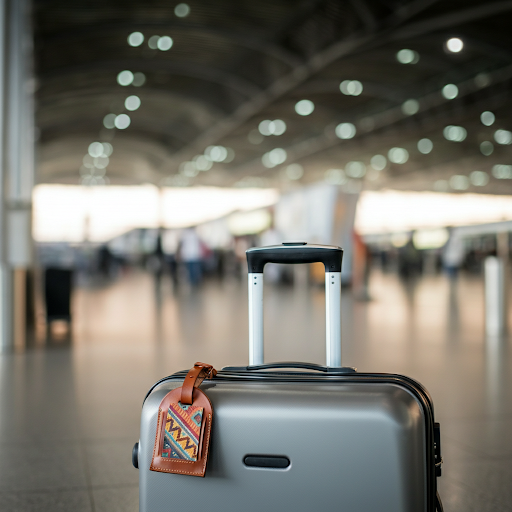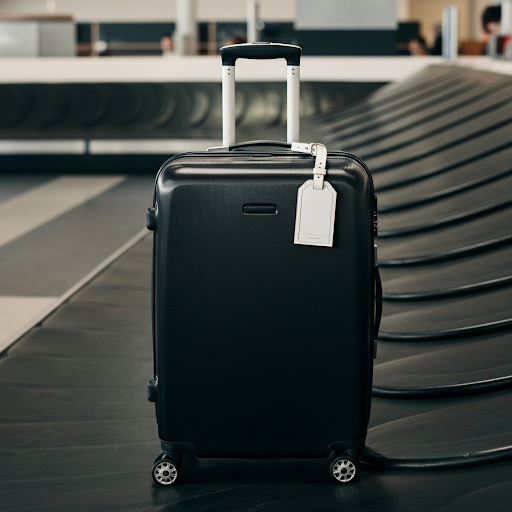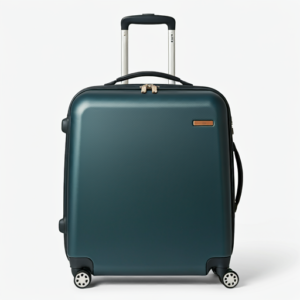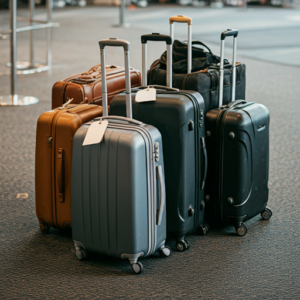In the hustle and bustle of air travel, where every second counts, luggage tags might seem like an insignificant detail. However, these unassuming identifiers play a crucial role in ensuring your belongings arrive safely at your destination. When considering whether are luggage tags necessary, remember that they can help prevent mix-ups and ensure your bag is returned to you, especially in the chaotic environment of baggage claim. While airlines provide their own tags, personal tags offer a higher level of reliability and security, answering the question, “are luggage tags necessary?” with a resounding yes. For frequent flyers, luggage tags can make a significant difference in travel efficiency and peace of mind, solidifying their necessity in modern travel.
Table of Contents
Beyond simply preventing mix-ups, luggage tags provide crucial contact information that can be used to reach you in case your bag is misplaced. This can be particularly helpful during busy travel seasons when airports are crowded and the risk of lost luggage increases. Imagine your bag accidentally ends up in Anchorage instead of Atlanta – your luggage tag becomes your lifeline.

Personal luggage tags often come with features that enhance security and durability, such as metal loops or leather straps, ensuring they withstand the rigors of travel. Unlike the ephemeral paper tags provided by airlines, these durable options are less likely to rip or tear off during transit. They are built to endure the journey, just like you.
For frequent flyers, the idea of having a unique and easily identifiable luggage tag can save valuable time at baggage claim. No more squinting at a sea of identical black suitcases! It can also add a touch of personal style to your travel gear, making your suitcase stand out among the multitude of similar-looking bags.
Luggage tags are not just practical but can also be a way to express your personality. With options ranging from vibrant colors to custom designs, you can choose a tag that reflects your style while serving its essential function. A splash of color or a quirky design can make your luggage as individual as more people than you are.
In today’s digital age, smart luggage tags and accessories that integrate with luggage trackers offer an advanced solution for travelers. These tags and accessories can be synced with your mobile phone, allowing you to monitor your bag’s location in real-time, providing peace of mind during your travels. It’s like having a personal assistant for your luggage, keeping you informed of its every move.
Choosing the Right Luggage Tag
Types of Luggage Tags
The world of luggage tags offers a surprising variety of materials, each with its own advantages. Choose from metal luggage tags, plastic, silicone, or leather for durability and long-lasting use. Each material has its unique benefits: metal luggage tags are incredibly robust and resistant to damage, making them ideal for frequent flyers who need something that can withstand rigorous handling. Think of them as the armored knights of the luggage tag world. Plastic and silicone tags, on the other hand, offer flexibility and a variety of colors and designs, allowing travelers to express their personal style. They are the playful and vibrant members of the tag family. Leather tags provide a classic and sophisticated look, often favored by business travelers for their professional appearance. They exude an air of timeless elegance.
Consider smart luggage tags that can be paired with trackers like Tile to locate your suitcase. These innovative tags integrate seamlessly with digital tracking devices, allowing you to monitor your luggage’s location in real-time through your mobile phone. This feature is particularly useful for those who carry precious cargo or are concerned about lost luggage. By syncing with your mobile device, smart tags offer peace of mind and a higher level of security during air travel. They are the tech-savvy guardians of your belongings.
Look for luggage tags with removable cards for adding or updating your information. This feature ensures that your contact info is always current, reducing the risk of your bag being lost due to outdated details. Removable cards also allow you to quickly switch out information for different trips, such as adding your own phone number, hotel or flight number for your next adventure. This adaptability is greatly appreciated by travelers who frequently change destinations, ensuring that their luggage tags always provide enough information for airline staff to identify and return their bags promptly.
Design Considerations
Opt for luggage tags with bold colors, personalized options, or unique patterns to make them easy to spot at baggage claim. Imagine a sea of black suitcases slowly circling the carousel – your brightly colored tag will be a beacon in the monotony! Brightly colored or uniquely designed tags not only help in quickly identifying your luggage but also serve as a deterrent against theft, as thieves are less likely to target bags that stand out. Additionally, vibrant tags can add a touch of fun and personality to your travel gear, making your suitcase not just a functional item but also a reflection of your style.

Consider customizable tags with initials or a photo for added recognition. Personalized tags can be particularly helpful in busy airports where many bags look alike. By adding your initials or a favorite photo, you create an immediate visual cue that distinguishes your luggage from others, reducing the chances of someone else mistakenly grabbing your bag. Customization also allows for photo, for a sentimental touch, making your luggage feel more personal and familiar.
Choose a luggage tag with a sturdy design and high-quality materials. Investing in tags made from durable materials like metal or high-grade leather ensures that they withstand the wear and tear of travel. A well-constructed tag is less likely to break or fall off, providing consistent identification of your bag throughout your journey. High-quality materials also often come with additional security features, such as secure fastenings or weather-resistant finishes, offering peace of mind that your contact information remains intact and visible.
What to Include on Your Luggage Tag
List your name, email address, mobile phone number, and hotel information on luggage tags. Including your mobile phone number ensures that you can be contacted quickly if your bag is found, while an email address provides an alternative means of communication. Adding your own address and hotel information is especially useful for travelers who are on multi-leg trips, as it helps airline staff identify your current location in case your luggage needs to be delivered directly to your accommodation.
Exclude your home address to avoid burglary, but consider listing your passport as workplace address or home address without apartment number. By omitting your full home address, you reduce the risk of potential security breaches while still providing enough information for your bag to be returned. Using a workplace or business address can be a safer alternative, ensuring that your luggage has a reliable point of contact if needed.
Keep a second copy of the information inside the luggage. This practice acts as a backup in case data on the external tag is lost or damaged during transit. Secure the information inside a small, waterproof pouch or envelope to protect it from damage. This internal copy should mirror the details on your external tag, ensuring that airline staff have multiple ways to identify and return your luggage promptly. Additionally, consider including a copy of your itinerary or flight number details to provide further context for your travel plans, aiding in the recovery process if your luggage is misplaced.
Luggage Tag Placement and Security
Attach your luggage tag to paper inside of the handle or strap of your bag where it will be easy to spot. This strategic placement not only helps you quickly identify your luggage among a sea of similar bags but also ensures that airline staff can easily access your contact information if needed. Consider using a brightly colored or uniquely designed tag to further enhance visibility and deter potential thieves.
Consider using both a luggage tag and a tracker inside your bag for added security. Combining a traditional luggage tag with a modern tracking device offers a dual layer of protection, significantly reducing the chances of your luggage being lost. While the tag provides essential contact details, the tracker can offer real-time location updates via your mobile phone, allowing you to monitor your bag’s journey. This combination is especially beneficial for those carrying precious cargo or traveling through busy airports where the risk of lost luggage is higher.
Take a photo of your luggage and keep it in a secure location, such as an album on your iPhone, for identification purposes. Having a visual record of your suitcase can be invaluable if your luggage is misplaced. The photo serves as a quick reference that can be shared with airline staff or authorities to aid in the search and recovery process. Ensure that the image captures any distinctive features of your bag, such as unique patterns, colors, or stickers, which can help distinguish it from others. Additionally, keeping both print or digital copies of your luggage tag information and itinerary alongside the photo can streamline communication and expedite the retrieval process.
Airline Regulations and Luggage Tags
Airlines provide paper tags with flight information, but these can be easily ripped or lost. These tags are typically attached at check-in and contain critical details about your trip and your next flight out, such as your destination, flight number, and airline code. However, due to their flimsy nature, they are susceptible to damage during transit, which can lead to lost luggage and delays in baggage claim.

Know your airline’s identifiers to help prevent mistakes and ensure your bag is returned to you. Familiarizing yourself with your airline’s specific codes and identifiers can be a proactive step in safeguarding your luggage. This knowledge can assist you in double-checking that your bag is correctly tagged and routed to the right destination, minimizing the risk of it being misplaced or sent to the wrong location.
Check with your airline for any specific regulations or requirements for luggage tags. Different airlines may have varying policies regarding luggage tags, particularly concerning the information that should be included and the types of tags permitted. Some airlines may offer additional options for electronic tagging or provide recommendations and tips for securing your luggage. Staying informed about these regulations can help you comply with airline policies and ensure a smoother travel experience.
Reducing the Risk of Lost Luggage
Use a luggage tag with a metal loop or sturdy strap to prevent it from getting lost or torn. Opting for durable materials like metal or high-grade leather ensures your tag stays firmly attached, even during rough handling. This durability is particularly beneficial for frequent flyers who often face rigorous travel conditions. A well-secured luggage tag not only helps in identifying your bag but also deters potential theft, as it shows that you take your luggage’s security seriously.
Consider investing in a suitcase lock to add an extra layer of security. A suitcase lock can protect your luggage from unauthorized access, keeping your belongings safe during transit. Choose a TSA-approved lock to ensure compliance with airport security regulations while maintaining the security of your precious cargo. In addition to deterring theft, a lock can prevent accidental openings, ensuring that your items stay securely packed throughout the journey.
Keep a record of your itinerary, including dates and places you will be staying, and store it inside the suitcase. This information acts as a backup in case your passport or external luggage tag is lost or damaged. By placing a copy of your itinerary inside your suitcase, you provide airline staff with vital details that can aid in the recovery of your bag if it goes missing. Additionally, consider including a copy of your flight number and hotel reservations, which can expedite the process of reuniting you with your luggage. This practice not only enhances the chances of a swift recovery but also provides peace of mind, knowing that all necessary information is readily accessible.
Alternatives to Traditional Luggage Tags
Consider using a tracking device, such as an Air Tag, to keep track of your luggage. These compact devices can be easily attached to your suitcase or placed inside, providing a reliable way to monitor your bag’s location. With the ability to connect to your mobile phone, Air Tags offer real-time updates and alerts, ensuring you are always informed about your luggage’s whereabouts. This feature is particularly beneficial during layovers or when your luggage is out of sight, offering peace of mind and reducing the worry of lost luggage.
Look into smart luggage tags that can be paired with your mobile phone for real-time tracking. These innovative tags not only serve as a traditional luggage identifier but also integrate advanced tracking technology. By syncing with apps on your phone, smart tags allow you to keep tabs on your suitcase’s journey, providing notifications if it strays from its intended path. This technology is especially useful for frequent flyers and those carrying precious cargo, as it adds an extra layer of security and convenience to your travel experience.
Use a luggage tracker to locate your suitcase and receive updates on its location. Luggage trackers are designed to work in tandem with your existing travel gear, offering seamless integration and easy setup. By providing real-time location data, these devices help ensure that your luggage remains within reach, even in the busiest of airports. The ability to receive instant notifications about your bag’s status can greatly reduce the stress associated with air travel, making your next trip more enjoyable and worry-free. Additionally, luggage trackers can be a cost-effective solution for those who travel frequently, offering a valuable tool for safeguarding your belongings.
Do Carry-On Bags Need Luggage Tags?
Yes, even carry-on bags need luggage tags to prevent mix-ups and ensure they are returned to you. While your carry on take-on bags are typically kept with you during the flight, there are situations where they may need to be checked at the gate, especially on full flights or when overhead storage is limited. In such cases, having a luggage tag can make all the difference in ensuring your checked bag that is correctly identified and returned to you promptly.
Conclusion – Are Luggage Tags Necessary?
Finally, consider packing for each trip as if your only carry on luggage full-on bag might get checked. This means including essential items such as medications, travel documents, and valuables in your personal item, just in case your carry-on needs to be stowed in the cargo hold. By packing and being prepared for this possibility, you can avoid potential disruptions to your travel plans and ensure that you have everything you need at hand, regardless of where your bag ends up during the flight.
Luggage tags can help you reunite with your bag if it is accidentally taken by another traveler. In busy airports, it’s not uncommon for travelers to mistakenly grab the wrong bag, especially if many carry-ons look similar. A distinctive luggage tag can serve as a visual reminder of ownership, reducing the likelihood of mix-ups. Furthermore, in the event that your bag is taken by mistake, the contact information on your purse or luggage tag provides a direct way for the other traveler or airline staff to reach you.












